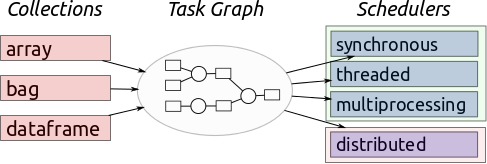Dask¶
Dask is a flexible parallel computing library for analytic computing.
Dask is composed of two components:
- Dynamic task scheduling optimized for computation. This is similar to Airflow, Luigi, Celery, or Make, but optimized for interactive computational workloads.
- “Big Data” collections like parallel arrays, dataframes, and lists that extend common interfaces like NumPy, Pandas, or Python iterators to larger-than-memory or distributed environments. These parallel collections run on top of the dynamic task schedulers.
Dask emphasizes the following virtues:
- Familiar: Provides parallelized NumPy array and Pandas DataFrame objects
- Flexible: Provides a task scheduling interface for more custom workloads and integration with other projects.
- Native: Enables distributed computing in Pure Python with access to the PyData stack.
- Fast: Operates with low overhead, low latency, and minimal serialization necessary for fast numerical algorithms
- Scales up: Runs resiliently on clusters with 1000s of cores
- Scales down: Trivial to set up and run on a laptop in a single process
- Responsive: Designed with interactive computing in mind it provides rapid feedback and diagnostics to aid humans

See the dask.distributed documentation (separate website) for more technical information on Dask’s distributed scheduler,
Familiar user interface¶
Dask DataFrame mimics Pandas - documentation
import pandas as pd import dask.dataframe as dd
df = pd.read_csv('2015-01-01.csv') df = dd.read_csv('2015-*-*.csv')
df.groupby(df.user_id).value.mean() df.groupby(df.user_id).value.mean().compute()
Dask Array mimics NumPy - documentation
import numpy as np import dask.array as da
f = h5py.File('myfile.hdf5') f = h5py.File('myfile.hdf5')
x = np.array(f['/small-data']) x = da.from_array(f['/big-data'],
chunks=(1000, 1000))
x - x.mean(axis=1) x - x.mean(axis=1).compute()
Dask Bag mimics iterators, Toolz, and PySpark - documentation
import dask.bag as db
b = db.read_text('2015-*-*.json.gz').map(json.loads)
b.pluck('name').frequencies().topk(10, lambda pair: pair[1]).compute()
Dask Delayed mimics for loops and wraps custom code - documentation
from dask import delayed
L = []
for fn in filenames: # Use for loops to build up computation
data = delayed(load)(fn) # Delay execution of function
L.append(delayed(process)(data)) # Build connections between variables
result = delayed(summarize)(L)
result.compute()
The concurrent.futures interface provides general submission of custom tasks: - documentation
from dask.distributed import Client
client = Client('scheduler:port')
futures = []
for fn in filenames:
future = client.submit(load, fn)
futures.append(future)
summary = client.submit(summarize, futures)
summary.result()
Scales from laptops to clusters¶
Dask is convenient on a laptop. It installs trivially with
conda or pip and extends the size of convenient datasets from “fits in
memory” to “fits on disk”.
Dask can scale to a cluster of 100s of machines. It is resilient, elastic, data local, and low latency. For more information see documentation on the distributed scheduler.
This ease of transition between single-machine to moderate cluster enables users both to start simple and to grow when necessary.
Complex Algorithms¶
Dask represents parallel computations with task graphs. These
directed acyclic graphs may have arbitrary structure, which enables both
developers and users the freedom to build sophisticated algorithms and to
handle messy situations not easily managed by the map/filter/groupby
paradigm common in most data engineering frameworks.
We originally needed this complexity to build complex algorithms for n-dimensional arrays but have found it to be equally valuable when dealing with messy situations in everyday problems.
Index¶
Getting Started
Collections
Dask collections are the main interaction point for users. They look like NumPy and pandas but generate dask graphs internally. If you are a dask user then you should start here.
Scheduling
Schedulers execute task graphs. Dask currently has two main schedulers, one for single machine processing using threads or processes, and one for distributed memory clusters.
Inspecting and Diagnosing Graphs
Parallel code can be tricky to debug and profile. Dask provides a few tools to help make debugging and profiling graph execution easier.
Graphs
Internally Dask encodes algorithms in a simple format involving Python dicts, tuples, and functions. This graph format can be used in isolation from the dask collections. Working directly with dask graphs is rare unless you intend to develop new modules with Dask. Even then, dask.delayed is often a better choice. If you are a core developer, then you should start here.
Help & reference
- Debugging
- Changelog
- Dask Cheat Sheet
- Presentations On Dask
- Development Guidelines
- Frequently Asked Questions
- Comparison to Spark
- Opportunistic Caching
- Internal Data Ingestion
- Remote Data Services
- Custom Collections
- Citations
Dask is supported by Anaconda Inc and develops under the BSD 3-clause license.